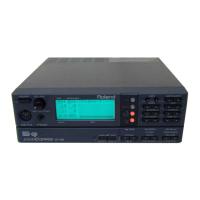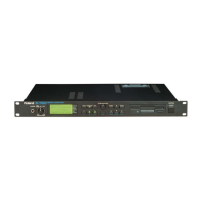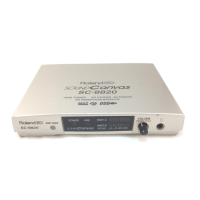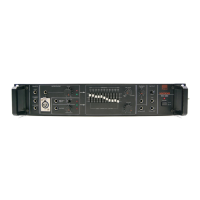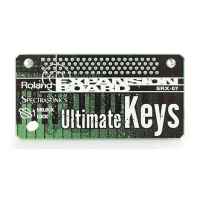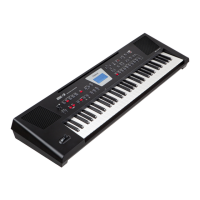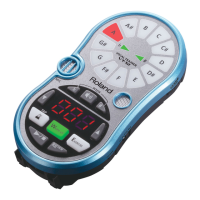Do you have a question about the Roland Sound Canvas SC-55mkII and is the answer not in the manual?
| Type | Sound Module |
|---|---|
| Sound Engine | LA synthesis |
| Polyphony | 28 voices |
| MIDI Channels | 16 |
| Sound Generation | PCM |
| Number of Sounds | 354 |
| Preset Patches | 128 |
| User Patches | 64 |
| Drum Kits | 9 |
| Wave Memory | 4 MB |
| Effects | Reverb, Chorus |
| MIDI | In, Out, Thru |
| Power Supply | AC adapter |
| Multitimbral | 16 |
| Connections | MIDI, Audio |
A set of recommendations to provide a way beyond proprietary design limitations.
Roland's universal specifications for standardizing sound generating device operation with MIDI.
Instructions for safe power supply use, including damage prevention.
Guidance on optimal unit placement to avoid damage and ensure performance.
Advice for cleaning and maintaining the unit for longevity and function.
Further safety advice, including protection from impact and electric shock.
Description of the controls and indicators on the front panel.
Description of the connectors and switches on the rear panel.
Step-by-step instructions for safely powering down the unit.
Instructions on operating the remote control unit, including range and functionality.
Procedures for setting the remote control reception switch to off.
Explanation of MIDI IN/OUT connectors and their usage with MIDI devices.
Details on connecting audio input and output jacks for external equipment.
Steps for connecting to Apple Macintosh and IBM PC AT computers via MIDI.
Explanation of computer switch settings for PC connections.
Instructions for connecting headphones, using the cord hook, and rack installation.
Instructions for selecting and playing different instrument sounds.
Detailed steps for choosing and changing instruments for each part.
Procedures for adjusting overall volume level and stereo panning for each part.
Steps for adjusting the intensity of reverb and chorus effects.
Instructions for changing the pitch of all parts using key shift.
Explains the relationship between Parts, Instruments, and MIDI channels.
Procedures for choosing and assigning drum kits to the drum part.
Adjusting the volume level and stereo panning for each part.
Setting the reverb and chorus levels for each part.
Adjusting the key shift for each part in semitone steps.
General instructions for setting various part parameters.
Instructions for changing USER settings, including instrument, volume, and pan.
Procedure for clearing current USER settings and returning to default or off state.
How to mute individual parts or all parts and lock settings.
How to listen to specific parts or all parts simultaneously.
Adjusting master tuning and fine-tuning the unit's pitch.
How to use the feature to play along with songs by muting parts.
How to switch the roles of MIDI IN1 and MIDI IN2 connectors.
Procedures for initializing to GM/GS formats and returning to factory presets.
How to select a sound map compatible with the MT-32 for tone arrangements.
Procedure for renaming patches and managing sound parameters.
Instructions for setting the bar display, peak hold, and LCD contrast.
How to select different variations or tones for instruments and via external devices.
How to enable or disable the reception of instrument change messages.
Setting the range for pitch bend and defining key range for effects.
Adjusting how velocity affects volume and setting velocity sensitivity offset.
Setting portamento duration and adjusting modulation intensity.
Adjusting expression level, selecting M/P mode, and portamento.
General instructions for setting various sound output parameters.
Adjusting vibrato rate, depth, and delay for pitch fluctuation effects.
Adjusting cutoff frequency and resonance for tonal shaping.
Adjusting attack, decay, and release times for sound envelopes.
General instructions for setting various sound parameter values.
Table listing available reverb types and their effects.
Table listing available chorus types and their effects.
Steps for selecting and applying different reverb and chorus types.
Information on maximum polyphony and how overload is handled.
Chart showing the priority order for parts when notes exceed polyphony.
Setting the voice reserve number for individual parts.
Diagram for sequencer connection and how to send setup data.
Steps for transmitting all parts and specified settings.
Steps for transmitting the settings of a specific part.
Procedure to change the MIDI reception channel for each part.
Explanation of MIDI message transmission and reception processes.
Description of MIDI connectors and how channels are used.
Instructions for using the MIDI IN1 and MIDI IN2 connectors for data transfer.
Overview of note, pitch bend, program change, and bank select messages.
Details on control change messages for modulation, pan, volume, etc.
How aftertouch affects sound and how to reset MIDI controllers.
How system exclusive messages control device-specific operations.
Managing GM/GS system control and master volume.
How to manage MIDI reception switches for instruments and functions.
How to change the device ID number for exclusive messages.
How to read and understand MIDI implementation charts.
Explanation of the General MIDI System standard for sound generation.
Explanation of Roland's GS Format standard for sound generation.
Wiring diagram for connecting to Apple Macintosh computers using RS-422.
Wiring diagrams for connecting to IBM PC/AT computers using RS232C.
Summary of system and all parts functions accessible with the ALL indicator on.
Summary of settings for each part when the ALL indicator is off.
Overview of other operational functions available on the unit.
Technical details about the SOUND Canvas unit, including number of parts, polyphony, and dimensions.
Technical details about the remote control unit, including operating range and power supply.
List of included accessories and optional items like rack mount adapters.
Important safety warnings and precautions regarding apparatus containing lithium batteries.
